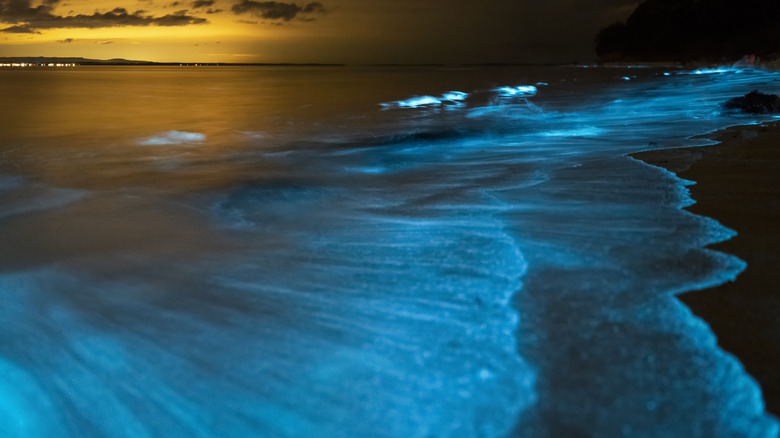What Causes Bioluminescent Waves?
If you've been to Newport Beach, California, in the spring and fall months, you might have witnessed the wonderful phenomenon that is the bioluminescent waves. Every year, walking along the beach at night, the ocean waves lapping against the sand glow with a bright, neon-like blue color — it's one of nature's most mesmerizing light shows, right up there with seeing the aurora borealis, and something that's definitely worth the visit for any Southern California tourist.
The ocean is already capable of many incredible phenomena, including the science that occurs where the Atlantic and Pacific Oceans meet. These glowing waters often look otherworldly, though, as if the sea itself were charged with electricity, but the phenomenon has a surprisingly biological origin. The light, in fact, comes from tiny marine organisms, often plankton called dinoflagellates, that emit light when disturbed by motion, like the rolling of waves or the movement of fish and boats.
This natural glow is actually believed to be a defense mechanism; when the plankton sense movement, it's believed that they flash to startle predators and chase them off. The chemical reaction that produces the light involving a compound called luciferin and an enzyme called luciferase, and this is actually the same process that makes fireflies glow on land.
Bioluminescent waves are more common in warm coastal regions and tend to appear during certain seasons when plankton populations boom, often after warm weather or nutrient-rich upwelling. Places like Puerto Rico's Mosquito Bay, California beaches, and the Maldives are all famous for the phenomenon of bioluminescent waves. While photos may make it look constant, the glow is fleeting, the bright blue light lasting only a few seconds before fading into darkness. Understanding what causes these waves can help remind us how even the smallest sea creatures, like plankton, help to transform the ocean into a glowing canvas of light and motion.
What is bioluminesence?
Bioluminescence is the natural ability that some living organisms have to produce and emit light. Unlike sunlight or fire, this light isn't generated from heat, but rather, it's the result of a chemical reaction taking place inside the organism's cells. The process typically involves two main ingredients: luciferin, a light-producing molecule, and luciferase, an enzyme that triggers the reaction. When luciferin reacts with oxygen, it produces energy in the form of visible light, often blue or green because those are the wavelengths that travel best through water.
What makes bioluminescence remarkable and awe-inspiring is how widespread and diverse it is across nature. It's found in everything from deep-sea fish and squid to jellyfish, plankton, fungi, and even some insects like fireflies. Each species uses bioluminescence differently: Some use it to attract mates, others to lure prey, and many, like the tiny dinoflagellates responsible for glowing waves, use it as a form of defense or communication.
In the ocean, bioluminescence is incredibly common. Scientists estimate that many deep-sea organisms can produce their own light, and for those living in the pitch-black environment of the deep sea, bioluminescence is a critical survival tool, acting like a flashlight, lure, or camouflage system.
Bioluminescence is not only one of nature's most beautiful phenomena but beyond that, it's also a subject of growing scientific interest. Researchers are studying the chemistry of bioluminescence for potential uses in medical imaging, environmental monitoring, sustainable lighting, and even the bioengineering of glow-in-the-dark cacti, showing that this ancient glow still holds modern-day promises.

